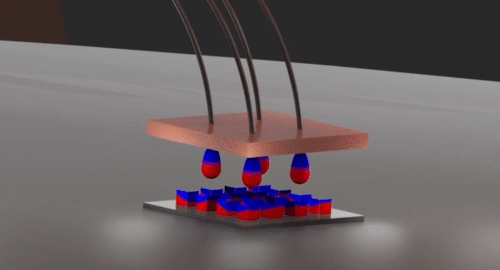This is a new method for miniaturising soft, ultra-compact and highly integrated sensor units in e-skin systems!
A research team from Chemnitz and Dresden has made significant progress in the development of sensitive electronic skin (e-skin) with integrated artificial hairs. Surface hair on our skin are so little that they can detect and predict even the tiniest tactile sensation, as well as recognise the direction of contact. Modern electronic skin systems lack this feature, making it impossible for them to gather vital information about their surroundings.
The team looked at a new way to develop very sensitive and direction-dependent 3D magnetic field sensors that may be used in an e-skin system (active matrix). The researchers devised a groundbreaking technique to downsizing and integrating 3D device arrays, taking a significant step toward simulating human skin’s natural touch. Professor Dr Oliver Schmidt, head of the Professorship of Material Systems for Nanoelectronics at Chemnitz University of Technology and Scientific Director of the Research Center for Materials, Architectures, and Integration of Nanomembranes (MAIN), headed the team.

Christian Becker, PhD student in Prof. Schmidt’s research group at MAIN and first author of the study says, “Our approach allows a precise spatial arrangement of functional sensor elements in 3D that can be mass-produced in a parallel manufacturing process. Such sensor systems are extremely difficult to generate by established microelectronic fabrication methods.”
An anisotropic magnetoresistance (AMR) sensor lies at the heart of the sensor system. Magnetic field changes can be precisely determined with an AMR sensor. AMR sensors are being utilised in a range of devices, for example, as speed sensors in cars or to determine the position and angle of moving components.
The researchers used the so-called “micro-origami method” to create the ultra-compact sensor system. Folding AMR sensor components into three-dimensional architectures that can resolve the magnetic vector field in three dimensions was done using this method. Micro-origami permits a high number of microelectronic components to fit into a compact space and be arranged in a geometry that standard microfabrication processes cannot achieve.
The researchers combined the 3D micro-origami magnetic sensor array into a single active matrix, allowing microelectronic circuitry to address and read each individual sensor. “The combination of active-matrix magnetic sensors with self-assembling micro-origami architectures is a completely new approach to miniaturize and integrate high-resolution 3D sensing systems,” says Dr Daniil Karnaushenko, who contributed decisively towards the concept, design and implementation of the project.
The researchers were able to combine 3D magnetic field sensors with magnetically rooted tiny hairs to create an artificial e-skin. Similar to real skin, which is interwoven with nerves, the e-skin is constructed of an elastomeric material into which the electronics and sensors are placed. The underlying 3D magnetic sensors can detect the movement and exact position of the magnetic root when the hair is touched and bends. As a result, the sensor matrix is able to capture not only the bare movement of the hair, but also the precise direction of the movement.
Read the entire study here.







